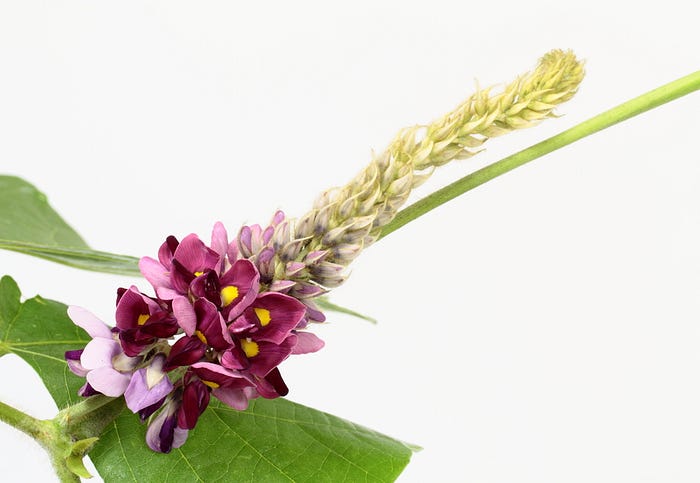Understanding Kudzu: Its Impact as an Invasive Species
Written on
The Adverse Effects of Kudzu on Ecosystems
In my earlier article, "The Environmental Impact of Lionfish as Invasive Species," I discussed how lionfish disrupt their non-native environments. Similarly, kudzu (Pueraria montana) is a plant that poses a significant threat to ecosystems. Originating from East Asia, kudzu was brought to North America in 1876 for various uses, including ornamental purposes, soil erosion control, and production of materials like fishing nets. However, by 2001, it had invaded approximately 3 million hectares (7.4 million acres) in the Eastern United States, expanding at a rate of about 50,000 hectares (124,000 acres) annually. To put this into perspective, that's roughly equivalent to the area of 5.6 million soccer fields, with an additional 93,000 soccer fields added each year, or about 256 every day!
As kudzu spreads, it significantly disrupts ecosystems by:
- Shading Native Species: Kudzu covers forest canopies, creating a permanent shade that hampers photosynthesis in other plants, ultimately leading to their decline and reducing biodiversity.
- Facilitating Wildfires: The plant acts as a fire ladder, making it easier for wildfires to spread.
- Depleting Soil Carbon: The soil beneath kudzu has lower carbon levels, which can hinder the growth of native flora.
- Altering Soil Fungi: The presence of kudzu changes the composition of underground fungi, negatively affecting native plants.
- Air Quality Degradation: Kudzu emits isoprene, a molecule that contributes to air pollution when combined with nitrogen oxides.
- Crop Virus Transmission: The plant is a vector for various viruses that can harm agricultural yields.
Kudzu's impact on agriculture is also severe, costing the U.S. timber industry between 100 to 500 million USD annually. Management efforts to remove kudzu from areas like electric cables add an additional financial burden, averaging 500 USD per hectare (268 USD per acre) per year. In farming, the spread of crop-related viruses, such as those affecting soybeans, can lead to losses of up to 2 billion USD in the U.S. alone.
Kudzu: So Bad It Even Makes the Air Worse! - YouTube
Understanding Kudzu's Prolific Growth
Kudzu's ability to proliferate stems from several factors:
1. Reproductive Strategies
Kudzu reproduces primarily through its extensive root system. Each root has numerous nodes that can detach from the parent plant after 1 to 3 years, allowing for the creation of clones that grow independently. This leads to a high density of kudzu clones in a given area, sometimes reaching 61 per square meter (5.7 per square foot). Additionally, kudzu produces seeds that can disperse up to 25 meters (82 feet) from the parent plant, although their primary means of reproduction remains through root cloning.
2. Environmental Adaptability
Kudzu thrives in various environments, from forest edges to agricultural fields, and can survive in mountainous regions and on islands. It tolerates various soil types, acidity levels, and can store water in its roots, allowing it to endure dry spells. Furthermore, kudzu can withstand extreme temperatures, making it resilient across different climates.
3. Allelopathy
Kudzu releases chemicals that inhibit the growth of other plants, a phenomenon known as allelopathy. These compounds can suppress germination, root development, and the beneficial interactions between native plants and fungi, giving kudzu a competitive edge.
4. Limited Natural Predators
Kudzu is not significantly affected by insects or fungi that would normally limit its growth. Its chemical makeup deters many plant-eating insects and harmful microorganisms, allowing it to flourish in non-native regions.
Kudzu Identification, History, and Control - YouTube
Taking Action Against Kudzu
Given the multitude of negative effects kudzu has on ecosystems and agriculture, it is crucial to manage its spread. Here are some practical measures we can take:
- Remove kudzu from your property, including the roots, as soon as possible.
- Utilize kudzu roots to extract nutritious starch.
- Feed kudzu to livestock or allow them to graze on it.
- Use the vines for crafting items like ropes, chairs, or hammocks.
- Incorporate kudzu leaves into your diet or as an ingredient in food products.
Which of these strategies can you implement in your daily life? Do you have other ideas to help manage kudzu? Your input in the comments can inspire us all to take action.
Did you find this article informative? If so, you might also enjoy my book, "A Guide to A Healthier Planet." Take a look inside!
About the Author
Dr. Erlijn van Genuchten is a globally recognized expert in environmental sustainability and science communication. She assists scientists in enhancing the dissemination of their findings, enabling us to apply scientific knowledge toward a sustainable future. Through her support of the United Nations, her book, "A Guide to A Healthier Planet," her YouTube channel "Xplore Nature," and her social media presence, Erlijn has motivated countless individuals worldwide.
